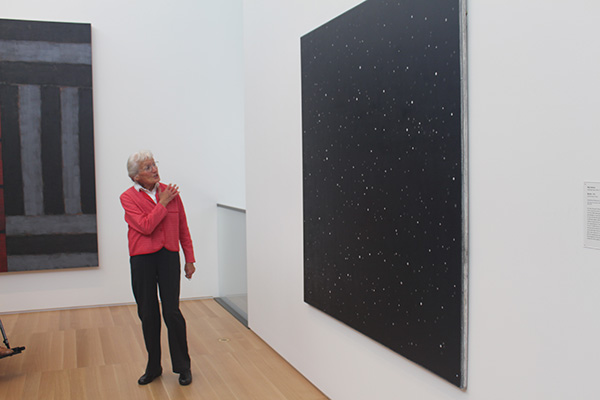[slideshow_deploy id=’5159′]
A geometric arrangement of glass and concrete sits in a grassy field at the end of a stone pathway. Stepping through glass doors, cleanly cut white stone walls and floor welcome you into an information area. Low-rise stairs on the far right-hand side of the room gradually deposit you into a softly lit room and to the middle of one of the most important privately owned collections of contemporary art in the world. Unmistakably modern, this impressive building previews the work it showcases inside: the Anderson Art Collection, now being shown next to the Cantor Arts Museum on Stanford campus.
The Anderson Collection consists of 121 modern and contemporary art pieces collected by Harry and Mary Margaret Anderson over the past 50 years. The Andersons donated their collection to Stanford for the benefit of the students and all who wish to come see it. They dedicated much of their life to the task of thoroughly researching modern art and seeking out culturally important pieces from California and the rest of the country. According to Norma Schlossman, a docent at the Cantor Arts Center for 15 years and a tour guide of the collection, the Andersons had no background in art when they began to collect paintings after a trip to France. The trip was the first time they were exposed to the art world, and since then they have taken numerous classes and read many books on the subjects of post World War II art and art collecting. When they came back to their home in Menlo Park, they began looking at contemporary artists in California, which started their earliest collection.
“They started looking around in their own backyard, and that’s when they discovered Bay Area figurativism,” Schlossman says. “One thing they said was they both have to appreciate it.”
To house the art, Stanford University constructed a permanent building adjacent to the Cantor Arts Center, a state-of-the-art establishment which echoes in every stone the modernist theme that dominates the collection. The first floor’s outermost rooms are encased in glass walls, with the second floor protruding slightly over the first. It is the newest addition to the Stanford Arts District along Palm Drive, strengthening the university’s initiative to promote the arts on its campus, according to the Anderson Collection’s website. The 33,000-square-foot building was designed by Richard Olcott and Timothy Artung, the same team that designed the recent Bing Concert Hall across the street from the Anderson Collection on Palm Drive.
The main gallery is situated on the second floor, accessible from the main staircase in the entrance hall. Natural light diffuses throughout the room through the ceiling, allowing the pieces to be viewed through a neutral setting, focusing attention on the art itself.
The collection features three dimensional art as well. Henry Anderson decided to donate the art to the university because his old company Saga Foods developed a connection with Stanford after it spent years catering food to the campus.
“Eventually they established the headquarters [of Saga Foods] in Menlo [Park], [and] they got affiliated with Stanford through that food distribution,” says Michael Estolano, a volunteer at the Anderson Collection’s front desk. “One of the art history professors here at Stanford was an adviser for them [the Andersons], told them which artwork to get, etcetera, so that’s how they established ties here at Stanford.”
Albert Elsen, an art history professor at Stanford who taught Anderson, was a crucial influence to their collecting and advised them throughout the process. He helped them build a significant collection that features many pieces from artists from all over the country.
According to Schlossman, the tours of the Anderson Collection highlights the pieces that are culturally important — the ones that people expect to see and which are the most famous. Schlossman tries to emphasize works that especially reflect on the Anderson’s main focuses: ingenuity, creativity and craftsmanship.
For instance, “Barrier,” a painting by Vija Clemins, incorporates several mediums into one work of art by basing a painting off a photograph of the sky. There is no evidence of brush strokes, thereby removing the artist’s physical presence in the piece due to the several layers of slightly translucent black paint. These layers also affect the white dots, or stars, giving each a unique shade.
Another piece is Robert Irwin’s “Untitled,” consisting of a convex acrylic half sphere raised above a white wall. Irwin sought to create a piece with no edges, accomplished by painting the outside of the sphere with the same shade of paint as the wall. In different lighting, different edges are detectable to the eyes. This is an important use of the function of the construction of the building, where natural light changes as the day progresses, therefore changing how the piece looks.
In all, every piece complements the collection, adding to a priceless assortment of art.





